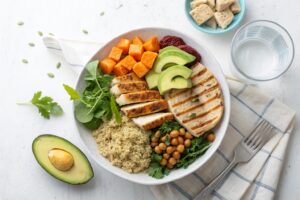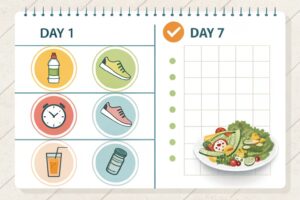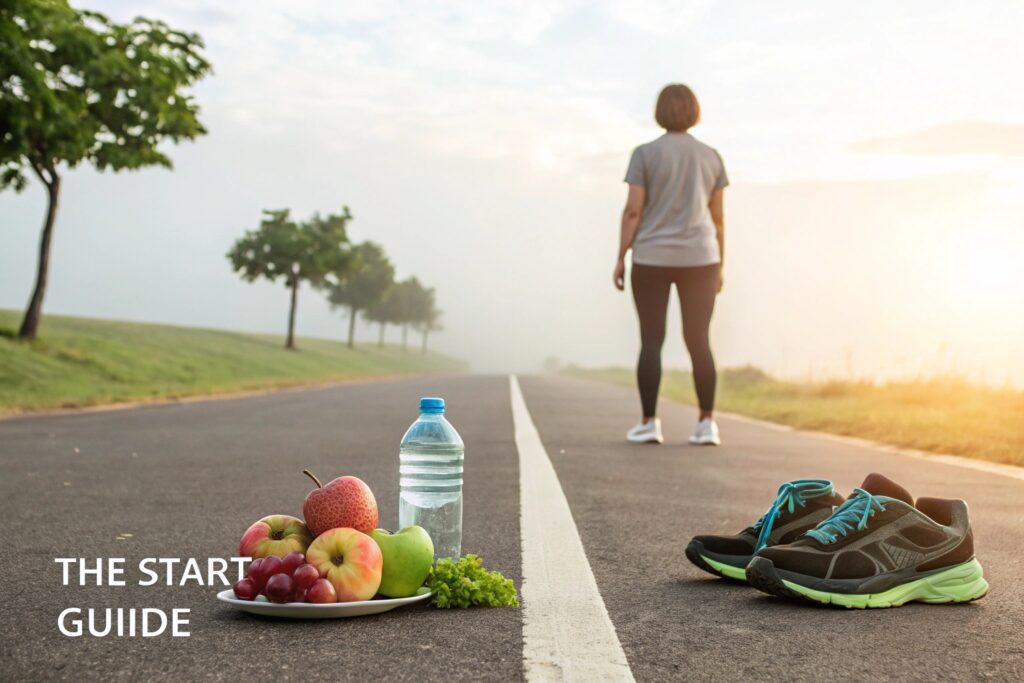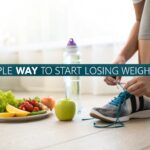Introduction
Beginner’s Guide to Losing Weight-Embarking on a weight loss journey can feel overwhelming. With endless information and conflicting advice, it’s easy to not know where to start. If you’re feeling lost, you’ve come to the right place. This Absolute Beginner’s Guide to Losing Weight is designed to cut through the noise and provide a clear, science-backed, and compassionate starting point. Forget quick fixes and extreme diets; we’re focusing on sustainable, foundational principles that build healthy habits for life. Consider this your friendly map to navigating the path toward a healthier you, one manageable step at a time.
Understanding the Core Principle: Calories In vs. Calories Out
At its most fundamental level, weight management is governed by the principle of energy balance, often simplified to “calories in versus calories out.” Your body requires a certain number of calories each day to maintain its current weight—this is known as your Total Daily Energy Expenditure (TDEE). It comprises your Basal Metabolic Rate (BMR—the calories you burn at rest for basic functions like breathing), the thermic effect of food (calories burned digesting food), and calories burned through physical activity. When you consistently consume fewer calories than your TDEE, you create a “caloric deficit.” This deficit forces your body to tap into its stored energy (body fat) to make up the difference, resulting in weight loss over time.
While the concept is simple, its application is where nuance comes in. Not all calories are created equal from a nutritional standpoint, even if they are mathematically equivalent for weight loss. For example, 200 calories from a sugary soda will affect your body differently than 200 calories from chicken breast and broccoli. The soda, high in sugar, can cause a rapid spike in blood sugar and insulin, leading to cravings and energy crashes. The chicken and broccoli provide protein, fiber, vitamins, and sustained energy, promoting satiety and nourishing your body. Therefore, while creating a deficit is key for fat loss, the quality of the calories you consume is paramount for overall health, adherence, and ensuring you feel good throughout the process.
Building Your Plate: Nutrition Fundamentals for Sustainable Loss

Macronutrients: Your Building Blocks for Energy
Understanding macronutrients—protein, carbohydrates, and fats—is crucial for constructing a balanced diet. Protein is the superstar for weight loss. It boosts satiety (feeling full), helps preserve lean muscle mass while you lose fat, and has a high thermic effect, meaning your body burns more calories digesting it. Aim to include a protein source—like chicken, fish, eggs, tofu, lentils, or Greek yogurt—in every meal. Carbohydrates are your body’s primary fuel source. Instead of fearing them, focus on choosing complex carbs like whole grains, oats, sweet potatoes, and legumes, which provide steady energy and fiber, over refined carbs like white bread and pastries. Healthy fats from sources like avocados, nuts, seeds, and olive oil are essential for hormone function and vitamin absorption and also contribute to feelings of fullness.
The Power of Mindful Eating and Hydration
How you eat is just as important as what you eat. Mindful eating involves paying full attention to the experience of eating without distraction. This means sitting down at a table, chewing slowly, and savoring each bite. It takes about 20 minutes for your brain to register that your stomach is full, so eating slowly can prevent overeating. Furthermore, never underestimate the role of hydration. Often, our bodies mistake thirst for hunger. Drinking adequate water throughout the day can help manage unnecessary snacking. A good rule of thumb is to drink half your body weight (in pounds) in ounces of water each day. For example, a 180-pound person would aim for 90 ounces of water.
Moving Your Body: Exercise for Health and Fat Loss
For absolute beginners, the thought of exercise can be intimidating. The key is to start slow and find activities you enjoy, making it more likely you’ll stick with them. The Centers for Disease Control and Prevention (CDC) recommends at least 150 minutes of moderate-intensity aerobic activity (like brisk walking, cycling, or swimming) per week, combined with muscle-strengthening activities on two or more days. Don’t feel pressured to run a marathon; a daily 30-minute walk is a phenomenal and often underrated way to kickstart your fitness journey. Consistency trumps intensity every time.
While cardio helps burn calories, strength training is non-negotiable for changing your body composition. Lifting weights or using resistance bands helps build and maintain lean muscle mass. Muscle is metabolically active tissue, meaning it burns more calories at rest than fat does. This helps increase your BMR over time, making it easier to maintain your weight loss. You don’t need a gym membership; bodyweight exercises like squats, push-ups, and lunges are incredibly effective. The goal is progressive overload—gradually increasing the difficulty of your workouts to keep challenging your muscles.
Navigating Mindset, Motivation, and Common Challenges
Weight loss is not a linear journey; it’s a marathon filled with peaks and valleys. One of the biggest challenges is the plateau, where the scale refuses to budge despite your efforts. This is normal and can be overcome by reassessing your calorie intake (as you lose weight, your TDEE decreases), varying your workout routine, or focusing on non-scale victories like how your clothes fit or having more energy. Another major hurdle is emotional eating. Developing strategies to cope with stress, boredom, or sadness without turning to food is a critical skill. This could involve going for a walk, calling a friend, practicing deep breathing, or engaging in a hobby.
Your environment plays a massive role in your success. If your kitchen is stocked with tempting junk food, willpower will eventually fail. Make it easy on yourself by creating a supportive environment. This means stocking your fridge with pre-cut fruits and veggies, keeping unhealthy snacks out of the house, and meal prepping on weekends to avoid desperate takeout decisions on busy weeknights. Remember, perfection is the enemy of progress. You will have off days. The most successful people are those who don’t let one bad meal or one skipped workout derail their entire week. They simply get back on track with the very next choice.
Putting It All Together: Your Actionable 7-Day Kickstart Plan

To make this guide truly practical, here is a simple, actionable plan for your first week. This isn’t a rigid diet but a framework to build upon. Day 1: Calculate your approximate daily calorie target using an online TDEE calculator and subtract 500 calories for a safe deficit. Day 2: Commit to drinking a large glass of water before every meal. Day 3: Go for a 20-minute walk. Day 4: Add one serving of vegetables to both your lunch and dinner. Day 5: Perform a simple bodyweight circuit: 3 sets of 10 squats, 10 push-ups (on knees is fine), and a 30-second plank. Day 6: Prepare two healthy meals for the upcoming week. Day 7: Reflect on your week. What felt easy? What was hard? Adjust for next week.
Tracking your progress is essential, but don’t become a slave to the scale. Weigh yourself once a week, at the same time of day under the same conditions. Better yet, take progress photos and body measurements, as these often show changes before the scale does. Consider using free apps like MyFitnessPal or Cronometer to log your food for a week. This isn’t meant to be a lifelong task, but it provides immense insight into your actual eating habits and portion sizes, helping you make more informed choices moving forward.
Sustaining Your Success: Building a Lifestyle, Not a Diet
The ultimate goal of this journey is to transition from a short-term “diet” mindset to a long-term “healthy lifestyle” mindset. This means finding a way of eating and moving that you can maintain forever without feeling deprived. Allow yourself flexibility. Incorporating planned treats or “cheat meals” can actually improve adherence by satisfying cravings and making your plan feel less restrictive. The 80/20 rule is a great guideline: aim to make healthy, nutrient-dense choices 80% of the time, allowing for more flexible choices the other 20%.
Your support system is invaluable. Share your goals with a trusted friend or family member who can offer encouragement. Even better, find a buddy who wants to make healthy changes too. You can share recipes, workout together, and hold each other accountable. Online communities can also be a fantastic source of motivation and advice from people on the same path. Remember, asking for help is a sign of strength, not weakness.
In conclusion, your weight loss journey is uniquely yours. This Absolute Beginner’s Guide to Losing Weight has provided the scientific foundation, nutritional knowledge, and practical strategies to empower your start. Be patient and kind to yourself. Lasting change takes time. Celebrate every small victory along the way. You have the power to build healthier habits and create a sustainable lifestyle that supports your well-being. Now is the time to begin. What’s the first small step you’ll take today? Share your commitment or questions in the comments below—we’d love to support you! For more in-depth guidance, check out our article on [5 Healthy Meal Prep Recipes for Busy Beginners].


